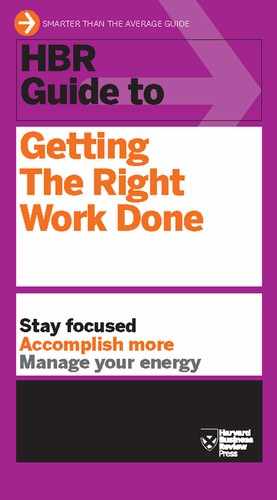Chapter 6
Say Yes to Saying No
by Alexandra Samuel
If your e-mail in-box looks like mine, it’s full of requests and invitations that promise challenging new projects, clients, and commitments. Sure, you enjoy the stimulation and excitement that come with these offers, but it’s a fine line. You have to be selective about what you take on—and disciplined about retiring long-standing activities to make room for new ones. You have to be able to say no. Frequently, politely, and effectively.
The good news is that the same technologies that threaten to overload you with things to say yes to can also help you say no. Here’s how:
Set your intentions
Before you say no, make it clear to yourself what you want to say yes to. Sites like 43Things.com and SuperViva.com can help you create lists of what you want to accomplish and experiences you want to have. Writing down your goals will help you clarify what’s important, identify what you want to eliminate, and get the community support to achieve it.
Prioritize your commitments
A simple Excel spreadsheet can help you evaluate what’s on your plate before you agree to take on more. Capture every project you’re working on—even ones you’ve only thought about—and list these in column A, one row per task. Use column B to assign a priority to each project, ranking items from 1-5. In column C, capture the name of anyone who could take over or help with certain projects. Sort your projects according to priority.
For high-priority tasks you’ve noted could be delegated, e-mail or meet with everyone to whom you hope to transfer projects.
Review with your boss the list of high-priority tasks that only you can handle. Are they aligned with her and your unit’s goals? If not, reevaluate to see if you should: shift priorities; delegate more of the projects; or defer some to a later date. (To download a sample Excel spreadsheet, visit my website at http://www.alexandrasamuel.com/career-work/excel-template-7-steps-to-achieving-your-goals.)
Make it easy to say “no”
When my in-box piles up with unanswered messages, you can bet that it’s full of e-mails that require a no—ones that I can’t bring myself to write. To make it easier, I’ve created a few different signature files in my e-mail client, with polite “no” messages for different circumstances: I’d love to join you, but my schedule is really booked for the next month; or Thanks for thinking of us, but we’re only taking on XYZ type of client right now; or That sounds like a great project, but my pro bono work is already committed for this quarter. Using these removes the burden of working up the energy to let someone down.
Make “no” your default answer
Say no to the majority of invitations and project offers you receive unless they meet a short set of criteria. For example, I look for conferences that combine business development (getting clients), professional development (improving skills or knowledge), and personal development (regeneration or personal growth), and attend only events that promise meaningful value on at least two of those fronts. Write down your criteria and stick them to your computer monitor, or put them on a digital sticky note.
None of these practices will eliminate the anxiety that comes from saying no or the fear that you may be passing up a fantastic opportunity. But it’s because saying no is so difficult that we need tools and systems to make it a little easier and a little more habitual. The more you say no, the better you’ll be able to focus on your most important work.
____________
Alexandra Samuel is the Director of the Social + Interactive Media Centre at Emily Carr University, and the co-founder of Social Signal, a Vancouver-based social media agency. You can follow Alex on Twitter at @awsamuel or her blog at alexandrasamuel.com.
______________
Adapted from content posted on hbr.org on January 8, 2010.
